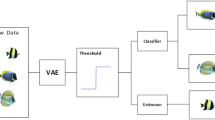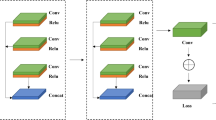Abstract
Classifying UWI (Under Water Images) is a challenging process due to the complex underwater nature and the illumination conditions. Marine preservationists and scientists find it crucial to regularly assess the species in their ecosystems and track population variations. While labor-intensive manual analysis has traditionally been employed, several CAD (Computer Aided Designs) for automated WI have been introduced. Nevertheless, the absence of an optimum model for automated WI classification persists. This challenge arises primarily from the complexities inherent in UWI, including variations in environmental illumination, less resolution, dynamic backgrounds and water turbidity among certain organisms. To address these, challenges, this work presents a SAE (Stacked Auto Encoder) based A-GEO (Adaptive Golden Eagle Optimizer) for UWI classification. The SAE is used for learning high level features of UWI and removing redundant features. Then, the A-GEO is used for optimizing the weights and bias of the SAE, ensuring that the SAE learns the efficient representations of the UWI. This work is evaluated on the two UWI datasets and achieved better accuracies of 98.7% (Dataset 1) and 98.6% (Dataset 2). The conducted experiments demonstrate that the proposed system exhibits precise classification of large scale UWI with a notable level of accuracy, surpassing conventional models.












Similar content being viewed by others
Data availability
Data sharing is not applicable to this article as no new data were created or analyzed in this study
References
Akhtarshenas A, Toosi R (2022) An open-set framework for underwater image classification using autoencoders. SN Appl Sci 4(8):229. https://doi.org/10.1007/s42452-022-05105-w
Chen X, Zhang P, Quan L, Yi C, Lu C (2021) Underwater image enhancement based on deep learning and image formation model. Accessed: Jul. 12, 2024. [Online]. Available: Preprint at https://arxiv.org/abs/2101.00991
Dharwadkar NV, Yadav AM, Kadampur MA (2022) Improving the quality of underwater imaging using deep convolution neural networks. Iran J Comp Sci 5(2):127–141. https://doi.org/10.1007/s42044-021-00093-3
Gašparović B, Lerga J, Mauša G, Ivašić-Kos M (2022) Deep learning approach for objects detection in underwater pipeline images. Appl Artif Intell 36(1):2146853. https://doi.org/10.1080/08839514.2022.2146853
Irfan M, Jiangbin Z, Iqbal M, Arif MH (2021) Enhancing learning classifier systems through convolutional autoencoder to classify underwater images. Soft Comput 25(15):10423–10440. https://doi.org/10.1007/s00500-021-05738-w
Irfan M, Zheng J, Iqbal M, Arif MH (2020) A novel feature extraction model to enhance underwater image classification. In: Brito-Loeza, C., Espinosa-Romero, A., Martin-Gonzalez, A., Safi, A. (eds) Intelligent Computing Systems. ISICS 2020. Communications in Computer and Information Science, vol 1187. Springer, Cham. https://doi.org/10.1007/978-3-030-43364-2_8
Jalal A, Salman A, Mian A, Shortis M, Shafait F (2020) Fish detection and species classification in underwater environments using deep learning with temporal information. Ecol Inform 57:101088. https://doi.org/10.1016/j.ecoinf.2020.101088
Kaur M, Vijay S (2024) Deep learning with invariant feature based species classification in underwater environments. Multimed Tools Appl 83(7):19587–19608. https://doi.org/10.1007/s11042-023-15896-8
Krishnaraj N, Elhoseny M, Thenmozhi M, Selim MM, Shankar K (2020) Deep learning model for real-time image compression in Internet of Underwater Things (IoUT). J Real Time Image Process 17(6):2097–2111. https://doi.org/10.1007/s11554-019-00879-6
Kumar N, Manzar J, Shivani & Garg S (2023) Underwater image enhancement using deep learning. Multimed Tools Appl 82(30), 46789-46809. https://doi.org/10.1007/s11042-023-15525-4
Li G et al (2023) MCANet: multi-channel attention network with multi-color space encoder for underwater image classification. Comput Electr Eng 108:108724. https://doi.org/10.1016/j.compeleceng.2023.108724
Mahmood A, Bennamoun M, An S, Sohel F, Boussaid F (2020) ResFeats: residual network based features for underwater image classification. Image Vis Comput 93:103811. https://doi.org/10.1016/j.imavis.2019.09.002
Malathi V, Manikandan A, Krishnan K (2023) Optimziedresnet model of convolutional neural network for under sea water object detection and classification. Multimed Tools Appl 82(24):37551–37571. https://doi.org/10.1007/s11042-023-15041-5
Mathur M, Goel N (2021) FishResNet: automatic fish classification approach in underwater scenario. SN Comput Sci 2(4):273. https://doi.org/10.1007/s42979-021-00614-8
Mittal S, Srivastava S, Jayanth JP (2023) A survey of deep learning techniques for underwater image classification. IEEE Trans Neural Netw Learn Syst 34(10):6968–6982. https://doi.org/10.1109/TNNLS.2022.3143887
Prasath R, Kumanan T (2022) Enhanced artificial bee colony approach for the enhancement and classification of underwater images. Int J Comput Appl 44(5):433–443. https://doi.org/10.1080/1206212X.2020.1784591
Qu P et al (2023) DAMNet: dual attention mechanism deep neural network for underwater biological image classification. IEEE Access 11:6000–6009. https://doi.org/10.1109/ACCESS.2022.3227046
Rathi D, Jain S, Indu S (2017) Underwater fish species classification using convolutional neural network and deep learning. In 2017 Ninth international conference on advances in pattern recognition (ICAPR) (pp. 1-6). IEEE, Bangalore, India, 27-30 December 2017.https://doi.org/10.1109/ICAPR.2017.8593044
Teng B, Zhao H (2020) Underwater target recognition methods based on the framework of deep learning: a survey. Int J Adv Robot Syst 17(6):1729881420976307. https://doi.org/10.1177/1729881420976307
Underwater Object Detection Dataset. Accessed: Jul. 12, 2024. [Online]. Available: https://www.kaggle.com/datasets/slavkoprytula/aquarium-data-cots
Verma G, Kumar M, Raikwar S (2024) F2UIE: feature transfer-based underwater image enhancement using multi-stackcnn. Multimed Tools Appl 83(17):50111–50132. https://doi.org/10.1007/s11042-023-17180-1
Xu S, Zhang M, Song W, Mei H, He Q, Liotta A (2023) A systematic review and analysis of deep learning-based underwater object detection. Neurocomputing 527:204–232. https://doi.org/10.1016/j.neucom.2023.01.056
Zhang D et al (2024) Robust underwater image enhancement with cascaded multi-level sub-networks and triple attention mechanism. Neural Netw 169:685–697. https://doi.org/10.1016/j.neunet.2023.11.008
Zhou Z, Liu M, Ji H, Wang Y, Zhu Z (2024) Underwater image classification based on EfficientnetB0 and two-hidden-layer random vector functional link. J Ocean Univ China 23(2):392–404. https://doi.org/10.1007/s11802-024-5472-9
Funding
Not applicable.
Author information
Authors and Affiliations
Contributions
The authors contributed to the design of the model, analysis of the data, and the computational framework. Material preparation and data collection were performed by Absa and Saju. Mary verified the analytical methods and encouraged Jarin to investigate the possibility of ensemble learning and supervised the findings of this work. All authors discussed the results and contributed to the final manuscript. All the authors read and approved the final manuscript.
Corresponding author
Ethics declarations
Ethics approval
Not applicable.
Consent to participate
Not applicable.
Consent for publication
Not applicable.
Conflict of interest
The authors declare no competing interests.
Additional information
Communicated by Hassan Babaie
Publisher's Note
Springer Nature remains neutral with regard to jurisdictional claims in published maps and institutional affiliations.
Rights and permissions
Springer Nature or its licensor (e.g. a society or other partner) holds exclusive rights to this article under a publishing agreement with the author(s) or other rightsholder(s); author self-archiving of the accepted manuscript version of this article is solely governed by the terms of such publishing agreement and applicable law.
About this article
Cite this article
S, A., John, S.P., Reeja, Y.M. et al. Enhanced underwater image classification using SAE-based adaptive golden eagle optimizer for high-accuracy marine species identification. Earth Sci Inform 18, 236 (2025). https://doi.org/10.1007/s12145-025-01732-0
Received:
Accepted:
Published:
DOI: https://doi.org/10.1007/s12145-025-01732-0




